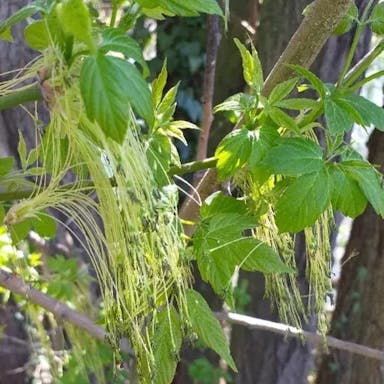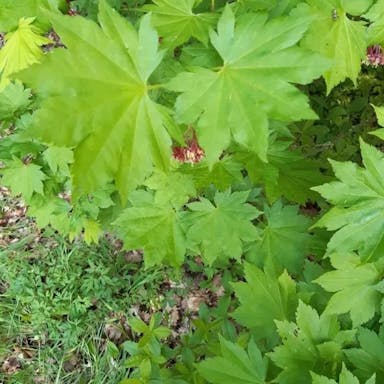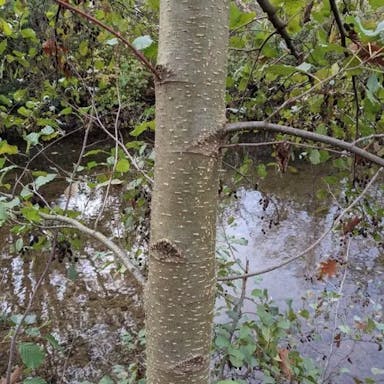Plum mango, scientifically known as Bouea oppositifolia, is a tropical fruit tree native to Southeast Asia. It belongs to the Anacardiaceae family and is commonly found in countries like Malaysia, Indonesia, and the Philippines. This plant is often cultivated for its delicious fruit and ornamental value in gardens and orchards. It is relatively easy to grow in tropical climates, requiring well-drained soil and regular watering. The fruit of this plant is known for its plum-like shape and mango-like taste, hence the name
Plum mango
- Scientific name
- Bouea oppositifolia
Basic Information
- Anacardiaceae Family Bouea Genus Plum mango Species
- Anacardiaceae > Bouea > Bouea oppositifolia
- 83%
- The Completeness of This Encyclopedia
Please help us complete the encyclopedia, Terrarium is a encyclopedia service to be completed with everyone in the world. Currently, this page is 83% complete. For more information on how to contribute, please click here.
- Broad-leaved tree
- Tree
- Height
- 1000cm ~ 2000cm
- Flower Color
- Leaf Color
- Anthesis
- spring
- Sunlight Exposure
Full Sun Long hours of sunlight from morning to afternoon Partial Shade A location in the shade of a tree or where either the morning or afternoon is shaded Full Shade A place where there is no direct sunlight
- Full Sun
- Hardiness Zones
This is an indicator to know to which zone each plant can winter. Knowing the zone of each plant gives you an idea of the cold temperature resistance when grown in the ground without a roof. 2: -42.7 to -40.0 3: -39.9 to -34.4 4: -34.3 to -28.9 5: -28.8 to -23.3 6: -23.2 to -17.8 7: -17.7 to -12.2 8: -12.1 to -6.7 9: -6.6 to -1.1 10: -1.0 to 4.4 11: 4.5 to 10.0
- 10
- Cold resistance
- Poor
- Heat resistance
- Excellent
- Habitat of origin
- Indonesia, Malaysia, Thailand
- Growth Rate
- Normal
What is Plum mango (Bouea oppositifolia)?
What is Plum mango (Bouea oppositifolia)
Flower meaning
The flower communication generally used across America for the botanical Plum mango shows: - Thankfulness - Enjoyment - Camaraderie One archetypal model is
Calendar of Plum mango (Bouea oppositifolia)
Calendar
The blooming period of the plum mango tree in America is generally spring until summer. Peak flowering happens late spring going into early summer. Blooming takes place once annually, lasting a couple weeks. Just how long full blooming takes can vary depending on precise climate and cultivation conditions. To promote extended blooming, guarantee the tree gets sufficient sunlight, water, and nutrients. Removing any dead or overgrown branches can also assist with more flowers. Furthermore, keeping ideal soil pH levels and preventing water stress can help make blooming last longer.
How to grow Plum mango (Bouea oppositifolia)
Watering
Plum mango needs good watering. Water evenly and check soil. Do not make soil too wet. In dormant time, water less. Check soil by finger and see if dry. Best to water in morning. Change watering for weather. Too much water causes root problems and fungus.
Soil and Fertilizer
Plum mango thrives in well-draining soil with a pH level between 5.5 and 7.5. It requires a balanced fertilizer made from natural nitrogen, phosphorous and potassium for optimal growth. Fertilizing should be done in spring before fresh expansion starts, and again in late spring or early summertime. During the period of plant development, a water-soluble fertilizer can be put on every 4-6 weeks, according to the maker's instructions for weakening and use. Stay away from over-fertilizing as it can prompt supplement uneven characters and harm the plant. Normally check the soil quality to guarantee it stays free and fruitful, advancing sound root improvement. Modify the soil with natural issue if important to keep up supplement levels.
Sunlight and Place
Plum mango plants thrive in full sun exposure, requiring at least 6-8 hours of direct sunlight daily for optimal growth. They have a high tolerance for heat, preferring temperatures between 70-90°F (21-32°C). In colder climates, they can withstand temperatures as low as 30°F (-1°C) for short periods. Plum mango plants should be placed in a location with good air circulation to prevent diseases. During the summer, they benefit from regular watering to maintain soil moisture. In winter, reduce watering frequency to prevent root rot. These plants do not require specific overwintering care but may benefit from being brought indoors in extremely cold climates. Overall, Plum mango plants are resilient to varying sunlight conditions but thrive best in full sun environments.
Advanced Information of Plum mango (Bouea oppositifolia)
Pruning
Plum mango requires regular pruning to maintain its shape, promote healthy growth, and increase fruit production. Do the pruning in late winter or early spring to avoid disrupting the plant's growth cycle. Remove unhealthy branches like dead or diseased ones, to improve air flow and sunlight. Shorten any long branches to encourage new growth and fruiting. After pruning, use some fertilizer to help new growth and ensure the plant gets enough water. Keep the Plum mango tree in good shape by pruning it regularly. This helps keep it healthy and producing fruit well.
Planting and Harvest
Plum mango is best potted for easy maintenance and control of its growth. To pot Plum mango, choose a container with drainage holes to prevent waterlogging. Use well-draining soil and plant the Plum mango at the same depth as it was in its previous container. After planting, water thoroughly and place in a location with bright, indirect sunlight. Repot Plum mango every 2-3 years in a slightly larger pot to accommodate its growth. If the roots become root-bound, gently loosen them before repotting to encourage healthy growth.
Propagation
Plum mango can be propagated through seeds, cuttings, and grafting. Seeds should be sown in well-draining soil, kept moist, and placed in a warm, sunny location. Cuttings should be taken from healthy branches, treated with rooting hormone, and planted in a mix of sand and peat moss. Leaf cuttings can also be used by taking a healthy leaf, placing it in a potting mix, and keeping it moist until roots develop. To multiply using different methods, start by sowing seeds for genetic diversity, then use cuttings for quicker propagation, and finally, grafting for maintaining specific traits. Harvest fruits when ripe for seed propagation.
Pests and Diseases
Plum mango is susceptible to various pests and diseases such as fruit flies, mango leafhoppers, powdery mildew, anthracnose, and bacterial black spot. These pests and diseases can cause significant damage to the plant, affecting its growth and fruit production. Fruit flies can infest the fruit, causing it to rot prematurely, while mango leafhoppers feed on the sap of the plant, leading to wilting and yellowing of leaves. Powdery mildew appears as a white powdery substance on the leaves, affecting photosynthesis. Anthracnose causes dark lesions on the fruit, reducing its quality, and bacterial black spot results in black spots on leaves and fruit. To prevent these issues, it is essential to practice good sanitation, proper pruning, and use of organic or chemical pesticides when necessary. Regular monitoring of the plant for any signs of pests or diseases is also crucial in preventing their spread.
Habitat of Plum mango (Bouea oppositifolia)
Habitat
Toxicity of Plum mango (Bouea oppositifolia)
Health Benefits
- edible
- edible
- Toxic
- No toxicity
NO DATA
Toxic for dogs and cats
NO DATA
Q&A of Plum mango (Bouea oppositifolia)
- What is a plum mango apple?
A plum mango apple, scientifically known as Bouea oppositifolia, is a tropical fruit native to Southeast Asia. It is not a hybrid of plum, mango, and apple, but rather, its name is derived from its unique flavor profile that resembles these three fruits. The fruit is small to medium in size, with a round or oval shape. The skin is thin and smooth, ranging in color from green to yellow when ripe. The flesh is juicy and sweet, with a slightly acidic taste, similar to a combination of plum, mango, and apple. Bouea oppositifolia is a species in the Anacardiaceae family, which also includes mangoes and cashews. It is a versatile fruit that can be eaten fresh, used in cooking, or processed into jams and jellies.
0
0
- What is a super plum mango?
A super plum mango, scientifically known as Bouea oppositifolia, is a tropical fruit native to Southeast Asia. It is a species of flowering plant in the Anacardiaceae family, which also includes cashews and poison ivy. The fruit is small and round, resembling a plum, and has a sweet, mango-like flavor. Hence, it is commonly referred to as a 'plum mango'. It is rich in vitamins and minerals, making it a nutritious addition to any diet. The tree on which it grows is evergreen and can reach heights of up to 25 meters. It is often cultivated for its fruit and as an ornamental tree due to its attractive foliage and fragrant flowers.
0
0
- Where can I find plum mango near me?
Plum mango, scientifically known as Bouea oppositifolia, is a tropical fruit native to Southeast Asia. You can typically find it in local markets or specialty grocery stores that carry exotic fruits. If you're unable to locate it nearby, consider checking online retailers that specialize in selling tropical fruits. They often have a wider variety and can deliver right to your doorstep. Remember, the availability of plum mango may depend on the season and your geographical location. It's always best to check with local suppliers or online stores for the most accurate information.
0
0
- What is maprang plum mango?
Maprang, also known as plum mango, is a tropical fruit-bearing tree scientifically known as Bouea oppositifolia. It is native to Southeast Asia, particularly in countries like Thailand and Malaysia. The tree produces small, oval-shaped fruits that resemble a combination of a plum and a mango, hence the name. The fruits are edible and are known for their sweet and slightly sour taste. They are often consumed fresh or used in various culinary applications such as in jams, jellies, and desserts. In addition to its culinary uses, the maprang tree is also valued for its ornamental appeal and is often grown in gardens and parks.
0
0
- Can I buy a plum mango tree?
Yes, you can purchase a plum mango tree, scientifically known as Bouea oppositifolia. This tropical fruit tree is native to Southeast Asia and is commercially cultivated in various regions. It's important to note that the tree thrives in warm climates and may not do well in colder regions. Before purchasing, ensure that your local climate is suitable for its growth.
0
0
- What are the benefits of plum mango?
Plum mango, scientifically known as Bouea oppositifolia, is rich in vitamins A and C, which are essential for boosting immunity and promoting skin health. It also contains dietary fiber that aids in digestion and helps maintain a healthy weight. Moreover, the fruit is packed with antioxidants that protect the body from harmful free radicals, thereby reducing the risk of chronic diseases. Its high water content also aids in hydration and helps maintain overall health. In addition, the plum mango is low in calories, making it a healthy choice for those watching their weight. Its sweet and tangy flavor also makes it a delicious addition to various dishes and desserts.
0
0
- What is plum mango fruit?
The plum mango, scientifically known as Bouea oppositifolia, is a tropical fruit native to Southeast Asia. It is a species of flowering plant in the Anacardiaceae family, which also includes mangoes and cashews. This fruit is small and round, resembling a plum in size and shape, hence its common name. It has a sweet and sour taste, similar to a mango, and is often used in local cuisines for its unique flavor. The plum mango tree is also known for its medicinal properties, particularly in traditional medicine.
0
0
- What is plum mango crisp?
Plum mango crisp is a dessert dish made from the fruit of the Bouea oppositifolia, commonly known as plum mango. This tropical fruit is native to Southeast Asia and is known for its sweet and tangy flavor. The crisp is prepared by combining sliced plum mango with sugar and spices, then topping it with a crumbly mixture of flour, butter, and sugar. It is then baked until the topping is golden and the fruit is bubbling. The result is a delightful combination of sweet, tart, and crunchy textures.
0
0
- choice
Plum mango varieties. 'Early Gold,' early fruiting sweet taste. 'Fairchild' compact size juicy fruit. 'Golden Queen' golden-yellow skin rich flavor. Selecting seeds, opt plump, undamaged ones. Seedlings, choose healthy green leaves sturdy stems. Ensure roots well-developed not root-bound. Conduct research specific varieties match preferences. Look reputable suppliers guarantee quality.
0
0
- Is plum mango grown in Thailand?
Yes, the plum mango, scientifically known as Bouea oppositifolia, is indeed grown in Thailand. It is a tropical fruit tree native to Southeast Asia, including Thailand, and is widely cultivated in these regions for its edible fruit. The plum mango thrives in the warm, humid climate of Thailand, producing fruits that are both sweet and sour. It is a popular ingredient in various Thai dishes and is also enjoyed fresh.
0
0
- Can you grow plum mangoes in Australia?
Yes, it is possible to grow plum mangoes, scientifically known as Bouea oppositifolia, in Australia. This tropical fruit tree is native to Southeast Asia and thrives in warm, humid climates. Australia's tropical and subtropical regions, such as Queensland and Northern Territory, provide suitable conditions for its growth. However, it's important to note that the tree requires well-drained soil and plenty of sunlight. It's also sensitive to frost, so protection during colder months is essential.
0
0
- What is a Marian plum mango?
The Marian plum mango, scientifically known as Bouea oppositifolia, is a tropical fruit-bearing tree native to Southeast Asia. It produces fruits that are a hybrid between a plum and a mango, hence the name. The fruits are small to medium-sized, with a sweet and sour taste similar to a mango but with a hint of plum. They are commonly used in various culinary applications, including desserts and sauces. The tree is also known for its ornamental value due to its attractive foliage and fragrant flowers.
0
0
- Is plum mango a tropical fruit?
Yes, the plum mango, scientifically known as Bouea oppositifolia, is indeed a tropical fruit. It is native to Southeast Asia, particularly in countries like Malaysia and Thailand, which are regions known for their tropical climate. The fruit thrives in warm, humid conditions, which are characteristic of tropical regions. Therefore, it's safe to classify the plum mango as a tropical fruit.
0
0
- How do you make a plum mango smoothie?
To make a plum mango smoothie, you'll need ripe Bouea oppositifolia fruits, commonly known as plum mangoes, along with other ingredients like yogurt, honey, and ice. Start by peeling and pitting the plum mangoes, then blend them with yogurt, honey, and ice until smooth. Adjust the sweetness with more honey if needed. This tropical fruit, native to Southeast Asia, lends a unique, sweet-tart flavor to the smoothie. Remember, the quality of your plum mangoes will significantly impact the taste of your smoothie, so choose ripe, fragrant fruits for the best results.
0
0
- What is Thai plum mango?
Thai plum mango, scientifically known as Bouea oppositifolia, is a tropical fruit tree native to Southeast Asia. It produces small, plum-like fruits that are commonly consumed in Thailand and other parts of the region. The fruits are typically eaten when they are ripe and have a sweet and sour taste. They are also used in various culinary applications, such as in salads, desserts, and as a flavoring for beverages. The tree is also known for its medicinal properties, with parts of it being used in traditional medicine.
0
0
- What's plum mango called in Vietnamese?
The plum mango, scientifically known as Bouea oppositifolia, is referred to as "Xoài mận" in Vietnamese. This tropical fruit is native to Southeast Asia, including Vietnam, and is highly valued for its sweet and tangy flavor. It's important to note that the term "Xoài mận" directly translates to "plum mango", reflecting the fruit's unique taste profile that combines the flavors of both plums and mangoes.
0
0
- What is a sour plum mango?
A sour plum mango, scientifically known as Bouea oppositifolia, is a tropical fruit tree species native to Southeast Asia. It is part of the Anacardiaceae family, which also includes mangoes and cashews. The fruit it produces is small, round, and typically yellow or orange when ripe. It has a unique flavor profile that combines the tartness of a plum with the sweetness of a mango, hence the name "sour plum mango". This fruit is often consumed fresh, but can also be used in various culinary applications such as jams, jellies, and beverages.
0
0
- How do you make pickled plum mango?
To make pickled plum mango, also known as Bouea oppositifolia, you first need to gather ripe plum mangoes, sugar, salt, and vinegar. Start by washing the mangoes thoroughly and cutting them into slices, discarding the seed. Next, mix equal parts of sugar, salt, and vinegar in a bowl until fully dissolved. Place the sliced mangoes in a jar, pour the mixture over them, and ensure they are fully submerged. Seal the jar and let it sit for at least a week to allow the mangoes to pickle. Remember, the longer they sit, the more intense the flavor will be.
0
0
- Can I buy a plum mango plant?
Yes, you can purchase a plum mango plant, scientifically known as Bouea oppositifolia. This tropical fruit tree is native to Southeast Asia and is commercially cultivated in various regions. It's important to note that the plant requires a warm, humid climate to thrive. Please ensure you have the appropriate conditions for its growth before making a purchase.
0
0
- Where can I buy plum mango?
Plum mango, scientifically known as Bouea oppositifolia, can be purchased from various online plant and seed retailers, as well as local nurseries that specialize in exotic fruit trees. Please note that availability may vary depending on your location and the season. It's also important to ensure that the retailer is reputable to guarantee the quality and authenticity of the plant.
0
0
- What's the skin of a plum mango like?
The skin of a plum mango, scientifically known as Bouea oppositifolia, is typically smooth and thin. It has a yellowish to orange color when ripe, similar to many other mango varieties. The skin is edible but is often peeled due to its slightly bitter taste. It's important to note that the texture and taste of the skin can vary depending on the specific variety and ripeness of the fruit.
0
0
- What's plum mango called in Chinese?
The plum mango, scientifically known as Bouea oppositifolia, is referred to as "杨桃" in Chinese. This tropical fruit is native to Southeast Asia and is particularly popular in China for its sweet and tangy flavor. Please note that the Chinese name "杨桃" is also used for other fruits in the same family, such as the star fruit. Therefore, it's important to specify "Bouea oppositifolia" when discussing the plum mango in a scientific context to avoid any confusion.
0
0
- What is peach plum mango strain?
The Peach Plum Mango strain, also scientifically known as Bouea oppositifolia, is a type of fruit-bearing tree native to Southeast Asia. This strain is renowned for its unique fruit, which bears a striking resemblance to a peach, plum, and mango in terms of taste and texture. The fruit is typically consumed fresh, but can also be used in various culinary applications due to its sweet and tangy flavor profile. In terms of cultivation, the Peach Plum Mango strain thrives in tropical climates and requires ample sunlight and well-drained soil to grow optimally.
0
0
- What does plum mango taste like?
Plum mango, scientifically known as Bouea oppositifolia, has a unique taste profile. It is often described as a blend of mango and plum flavors, hence its common name. The fruit has a sweet and slightly tangy taste, similar to a ripe mango, but with a hint of plum's tartness. Its texture is juicy and somewhat fibrous, akin to that of a traditional mango. In addition to its fresh consumption, plum mango is also used in various culinary applications, including jams, jellies, and sauces, where its distinctive flavor can be fully appreciated.
0
0
- What is gandaria plum mango?
Gandaria, also known as plum mango, is a tropical fruit-bearing tree scientifically named Bouea oppositifolia. This tree is native to Southeast Asia, particularly in countries like Malaysia, Thailand, and Indonesia. The fruit it produces is small, round, and typically yellow or orange when ripe. It has a unique taste that combines the flavors of mango and plum, hence its common name. The Gandaria tree is not only valued for its fruit but also for its timber and ornamental qualities. It's a versatile species that contributes significantly to its native ecosystems.
0
0
- Is there a recommended way to choose Plum mango?
Plum mango varieties include 'Fairchild', 'Manila', and 'Carabao'. 'Fairchild' is a dwarf variety suitable for small spaces. 'Manila' is known for its sweet flavor and fiberless flesh. 'Carabao' is a popular variety with a rich, sweet taste. When selecting seeds, choose plump, undamaged ones for better germination. For seedlings, look for healthy plants with vibrant green leaves and strong stems. Ensure the roots are well-developed and not root-bound. Check for any signs of pests or diseases before purchasing.






